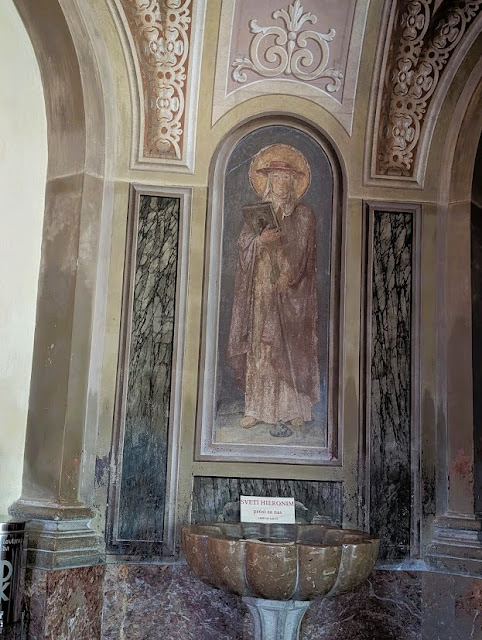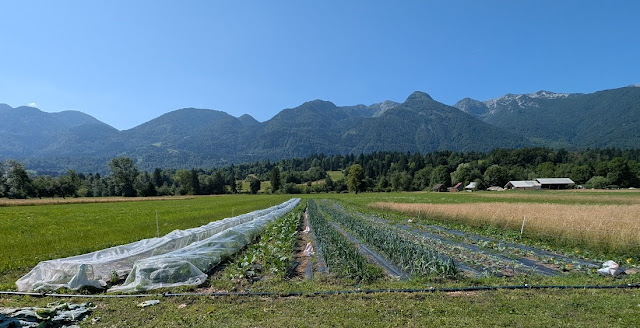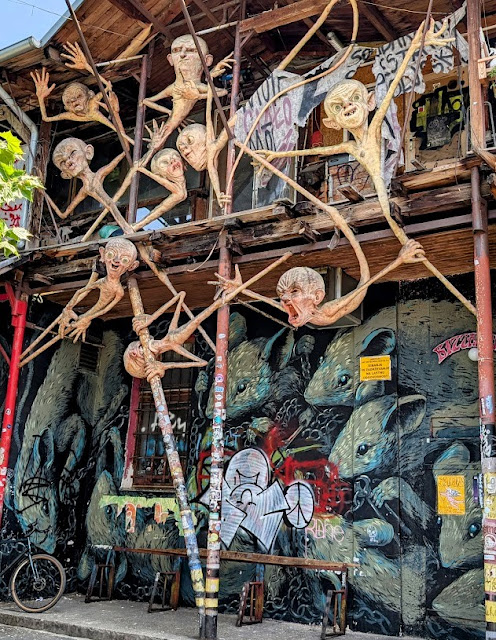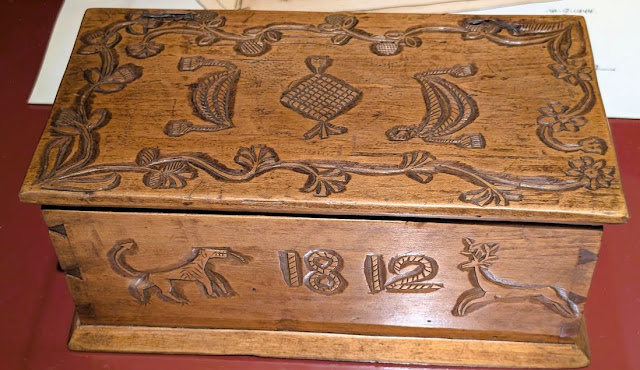So much for experienced travellers, this time, chaos seemed built into the journey from Timisoara to Ljubljana.
Perhaps our 3 am awakening to get to the airport in Timisoara didn't help, along with the anxiety of 'will the driver show up ?' at that hour, then having no prearranged transportation into Lubljana (about 24 km from that airport). The SIM card provider we wanted was supposed to be at the airport, but wasn't. Arg!
As the day went on, everything gradually came together, including stocking the fridge with groceries for the next five days.
We have now entered the country of Slovenia. Today, it is renowned for its natural beauty, outdoor activities, commitment to the environment and to sustainability.
In the 6th. Century various tribes migrated here. It has been part of the Roman Empire, the Holy Roman Empire and the Habsburg Monarchy, before becoming part of Yugoslavia and communist rule. In 1991, Slovenia declared its independence and is now a member of the EU and NATO.
The flag's colours are from the coat of arms of the Duchy of Carnolia, an area within the Habsburg monarchy with many Slovenes. The Mountain is Mount Triglav, Slovenia's highest mountain, and the wavy blue lines represent the sea and the rivers. Finally, the three six-pointed stars arranged in a triangle are from the coat of arms of the Counts of Celjie, another powerful family that influenced the Slovenians.
We have been moving pretty steadily for about two months and are tired of that, so we have deleted several stops from our schedule and are staying longer at fewer places. It feels like a good decision.
Evening finds us heading to Tivoli Park, about 3 blocks from our accommodation. Tivoli has everything you want in outdoor recreation. There are many paths for walking & cycling, an aquatic
center, water park, boxing gym, tennis and pickle ball courts, loads of space to kick and throw balls, play frisbee &/or frisbee golf, tight rope walk - yes!, walk the dog or play badminton. There are cultural spaces like Tivoli Castle, which
houses the International Center for Graphic Arts and the Cekin Mansion, which houses the museum of Slovenian contemporary history, a rose garden, lovely sculptures throughout, numerous ponds, secluded benches under ancient trees where
lovers can cuddle in private, and so much more. Judging by numbers and activities, locals of
all ages love this park, and while many people are here, it feels uncrowded.
From the moment we step out of our accommodation, we realize how carefully we need to mind the bicycle path, often separated from the sidewalk by only a line of paint. A lot of people here of all ages cycle, plus quiet electric scooters of all kinds ride the bike path. It's so easy to walk into their path when getting off a city bus or crossing the street. And they all ride like they are in a race. We respect the number of people who cycle here and haven't seen so many since Copenhagen and Amsterdam.
There was an interesting display on the
Jakopič Promenade, a wide boulevard that leads up to Tivoli Castle. It is the submissions for his year's (the 36th) biennial exhibition of
contemporary graphic arts.
The Biennale is known for pushing artistic
boundaries, and this year's theme explores the intersection of art, intuition,
and storytelling. The artists have quotes for each of their works, which
obviously have a connection for them.
SOME of the SUBMISSIONS on DISPLAY
Leading up to the Castle & Castle Grounds
The owner of this dog was not close by, and the dog was leaping about in the pond, all by itself, having a grand time.
So tired after a busy day.
Day 2 in Ljubljana finds us wandering the streets of the Old Town and taking a boat ride on the Ljubljanica River in a lovely wooden boat.
The boat travels under several bridges. The one we especially want to walk to after the boat ride is The Dragon Bridge, as the dragon is the protector of Ljubljana, who provides not only strength, courage and might, but wisdom. The story of Jason and the Argonauts, who slayed the dragon, is easily found on the internet.
Like any mascot, he appears here and there on signs, in name and promotional material. One example:
One bridge that links Old Town to Preseren Square, in the 1930's became three bridges thanks to the genious of Joze Plecnik. The Triple Bridges is on the UNESCO World Heritage site.
Also, on the above webpage, scroll down to see spectacular day and night photos of the pink Franciscan Church of the Annunciation.
Paul's photo captures it quite well.
Another notable bridge is the 'Shoemakers, or Cobblers Bridge'. The original bridge was covered with wood, which provided space for the workshops of shoemakers.
Butcher's Bridge or the Lover's Bridge is situated over what used to be the butcher shops. It connects the central market with the embankment. Today lovers put a lock on the bridge and throw the key into the river below.
Below is just one half of the central market; the other half is just as big. Today, there are more eateries than markets, but it's still worthwhile to have a look.
The people in these apartments on the river, must love where they are.
With no solid plans, one day became an
eclectic collection of diverse activities.
The morning started out with a visit to the botanical
gardens. Established in 1810, it's the oldest, continuously operating society in
Slovenia, collaborating with over 270 botanical gardens worldwide in
scientific research and education, and plays a critical role in growing and
protecting Slovenia's endemic, endangered, and/or vulnerable/rare species.

A quiet coffee break down by the river, then a walk through an African festival that is starting to set up for the weekend.Then it's a city bus ride to Metalkova
Mesto, which started out as one of the biggest urban squats in Europe in the old barracks of the Yugoslavian army.
In 1995, it was regulated as an
autonomous social and cultural center. The city tried to reach an agreement with the squatters/residents to leave the buildings but retain the functions of art and music. Something in between has happened. In 2005, it was designated a cultural
heritage site and plays a leading role in underground art and music in the
country, but people still live there. It was quiet when we visited midday, but it is said to be quite a happening place on the weekends.
Back to the old town for a wander and to sit by the river
watching family fun races, in a variety of watercraft (including SUPs). It seemed that the goal of having fun was more significant than winning.
Then we happened upon a
free and excellent jazz concert in Congress Square.
Dinner at a Chinese restaurant right beside our
accommodation was delicious, and a rarity for us. We have no access to
this quality of cooking where we currently live. There are many interesting shops in Old Town Ljubljana. This one resonated with Paul. It was a print shop doing it the old way, where every letter was on a metal plate, then had to be put in order, ink applied, and the printing done. Paul did this in his trophy and award business, mostly to print ribbons with words on them. Not many people do this today.
This shop changed it's window display every day. It is hard to see in the photos, but each one of these is a real purse.
One of our favourite days was a visit to the Slovene Ethnographic Museum. It has two permanent exhibitions that are advertised this way:
"Between
Nature and Culture" - This exhibition showcases the museum's vast collection of
over 3,000 objects representing both Slovenian and non-European ethnographic
heritage, focusing on the everyday and festive aspects of life.
"I,
We and Others: Images of my World" - This
exhibition delves into the human experience, exploring personal, communal, and
universal heritage through various themes and interactive elements
My favourite exhibit was on human perception of time. I had never thought of the concept of time in so many ways and relationships. Again, here is how the museum describes the exhibit.
Another fascinating exhibition was called 'Asia in the heart of Ljubljana'. This is the largest collection of objects from Asia in Slovenia. The collection was started by an officer who had been held prisoner in China about a hundred years ago. He later married a Japanese woman, and their collection expanded.
Some of the pieces were truly remarkable.

The item below is a skull drum from the Himalayan tantric traditional ritual of transcending the limitations of self. Two decapitated skulls of a young man and a young woman, turned opposite each other, make up the drum. The drum symbolizes the sexual union with the tantric emphasis on the unity of two and also symbolizes wisdom.
I think the items below were from the ethnographic heritage exhibition. It struck a chord as we have seen similar costumes in other countries. What we remember is that this is about the celebration of spring, awakening the light and the earth, with dancing and the cowbells. The similarities between cultures is so interesting.
Beekeeping of the native Carnolian bee was an integral part of life in Slovenia in the 19th century. Co-author of this display, Barbara Sosic says that: "Beekeeping is the poetry of agriculture."
The display included bee hives unique to Slovenia that have been used for thousands of years. A special honey bread, often made for special occasions and the art of the candle-maker.
MISCELLANEOUS FROM ETHNOGRAPHIC MUSEUM
After spending hours here, we head to the reasonably priced cafe for lunch.
On another day, we go to Ljubljana Castle as it has towered above us the whole time, and it seems like the thing to do. We take the funicular up and walk down.
We realize that this is a very sanitized castle, meant for tourists and families. Very disappointing and fairly expensive. There's a gift shop and two restaurants.
We climb to the top of this tower.
While up there, these costumed gentlemen come up with their bugles. People on the ground can hear them and are searching for them.
The first photo below is the view of Old Town from this tower, and the second is a view of the castle courtyard below.
There is a display of puppets, which were used in olden days to educate children, perhaps provide commentary or poke fun at those in power and to tell stories.
RANDOM PHOTOS FROM THE CASTLE
While other cities have a cafe culture, Ljubljana has a beer culture. Four thousand years ago, Slovenians were drinking a beer-like beverage. The biggest brewery is Lasko.Every day we walk past Union Brewery, established in 1864, then became a part of the Heineken family in 2015. We muse about going on their tour and decide not to.
Note the dragon as part of the logo.
We also pass by this modern fountain often.
This is my favourite garbage can in the Old Town.
In our neighbourhood is an interesting piece of street art that we forward on to one of our street artist friends.
This is St Bartholomew's Church, one of the oldest in Ljubljana. It is famous because a treaty was signed here wherein the Habsburgs returned Trieste to Venice.
MISCELLANEOUS FROM LJUBLJANA
As always we need to leave you with photos of a few nice buildings in Old Town.
Church doors in old town
Ziga Zois was a nobleman, entrepreneur, natural scientist and patron of the arts. His ideas were influential in the Enlightenment era.
Ljubljana is a wonderful city with so much to see and do. It's very walkable and a very worthwhile visit.
We are headed now to the Julian Alps area of Slovenia.
Until next time ...









































































































































